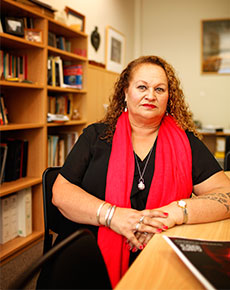AUT investigates motivations for second language learning

A team of language experts from Te Ipukarea, the National Māori Language Institute at Auckland University of Technology (AUT), are conducting a usage survey of Te Aka, the online Māori-English Dictionary and Index, in a bid to better understand how the Māori language is valued, by whom, and what the socio-cultural motivations for second language acquisition are.
AUT Professor in Māori Innovation and Development, Tania Ka’ai, says this investigation will enable a greater understanding of how useful the online resource is in Māori language revitalisation.
“Online dictionaries have the capability of being repositories of language and cultural knowledge because of their capacity to contain a wide range of information,” says Professor Ka‘ai.
“The mobility and convenience of an online dictionary means they are valuable tools for learners and speakers of the language, and this is particularly important for communities whose language is endangered such as New Zealand Māori.”
Te Aka is the world’s most comprehensive and popular online Māori language dictionary. For the year ending 28 July 2015, the website had received 3,001,408 visits from 218 countries with 1,189,704 unique visitors.
The team, comprising of AUT Professors Tania Ka’ai and John Moorfield, and John Patolo, a lecturer and researcher in AUT’s Faculty of Māori Innovation and Development/Te Ara Poutama, are hoping to reach as many survey respondents as possible to ensure there is enough data to come to strong, informed conclusions.
“The rich information collected from Te Aka users will enable us to better understand how important digital technology is in the preservation of te reo Māori,” says Professor Ka’ai.
“In addition, this survey will provide a sound template for conducting similar research for other online dictionaries including the Dictionary of Cook Islands Languages Online, which is also developed by AUT and Te Ipukarea in partnership with the University of the South Pacific and the Cook Islands Ministry of Education.”
Users of Te Aka are encouraged to scroll to the bottom of the www.maoridictionary.co.nz homepage to start the pop-up survey. There are four categories covered in the survey: general (about Te Aka), demographic/socio-economic, socio-linguistic and language proficiency.
About Te Aka
This online Māori dictionary was launched in 2006 and is based on the print editions of Te Aka Māori-English, English-Māori Dictionary and Index, now in its third edition. It is indexed to the Te Whanake Māori language series of narrative texts and resources – also developed by Professor Moorfield – to provide quick access to topics, grammatical and usage explanations, idioms and colloquialisms, maps and illustrations.
Since 2006, Professor Moorfield has been adding new headwords, new meanings of words, photographs, audio clips and example sentences, with translations, to Te Aka. There are now 17,421 headwords, most having a number of listed meanings and parts of speech, each with their own example sentence(s). By the end of this year, the number of headwords is likely to exceed 18,000.